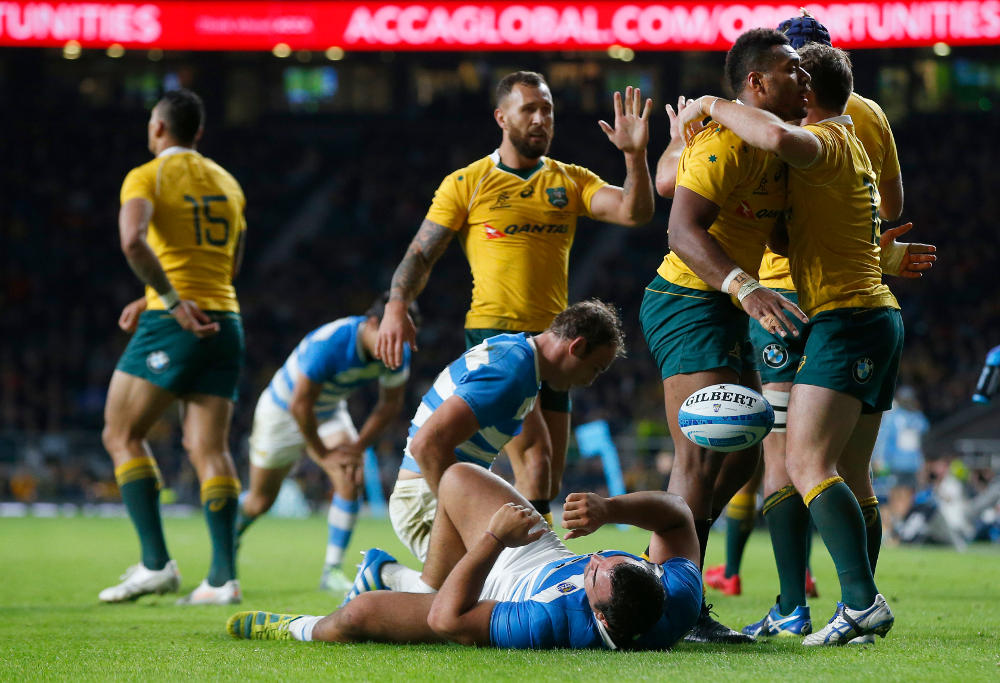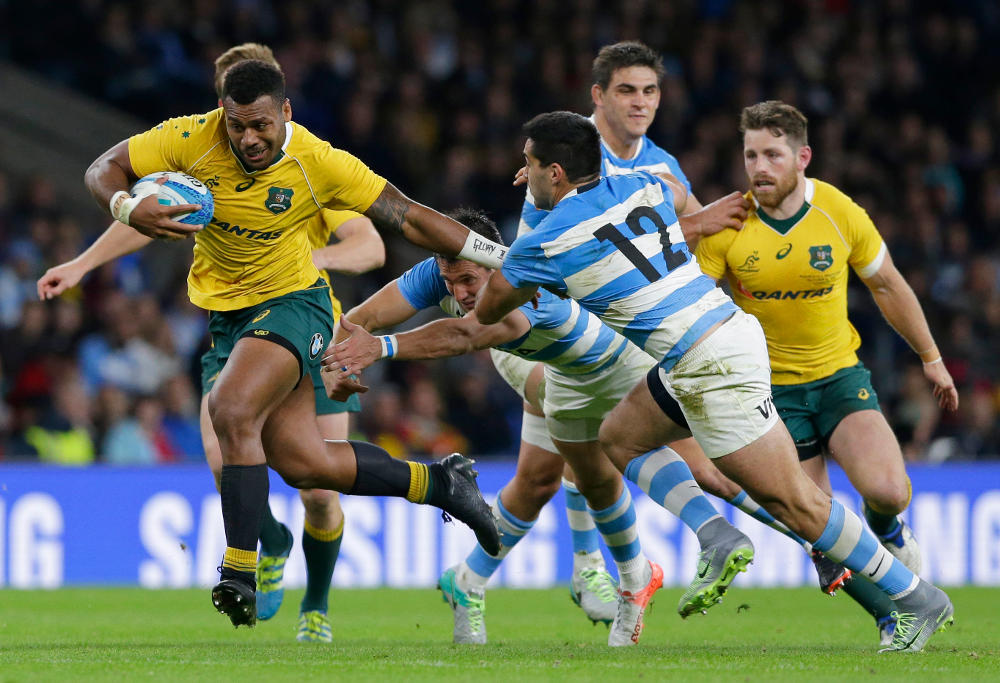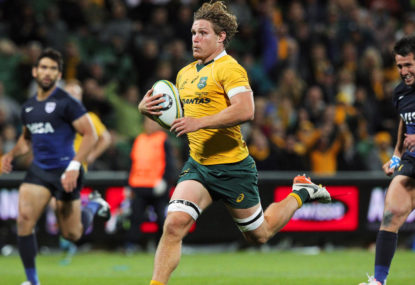Going into the final round of the Rugby Championship 2016 there were two questions that needed to be answered.
First: could the Wallabies win an away Test in 2016 to go with their home wins against the Springboks and the Pumas?
Second: could the All Blacks continue their relentless march towards a record number of Test wins for a top-tier team with a victory over the Springboks at Durban without their star halfback, Aaron Smith, deemed by Warren Gatland as the “best player in world rugby”?
The short answer to the first question is “yes.”
The long answer is the 33-21 win over the Pumas at Twickenham, with Australia scoring four tries to two, is that slowly, very slowly, too slowly perhaps, Michael Cheika is creating a new Wallabies squad to go forward to the Rugby World Cup 2019.
The new Wallabies are taking shape, at last. (Click to Tweet)
The rump of the 2015 squad which did well at Rugby World Cup 2015 is being eased out. The good news is the replacements look like becoming better players than those who they are replacing.
We see this metamorphosis best in the forwards. The three newish locks (using the old-fashioned rugby description) – Rory Arnold, Adam Coleman and Lopeti Timani – have size, some mongrel and strong work rates.

Paul Cully in the Sydney Morning Herald suggests that Timani will transfer in time to the number 6 position, which he (Cully) suggests is his best position for the Wallabies. There is something in this. Timani could play the Jerome Kaino game on the short side zone and be a menace to the opposition on the gain line with the ball and on defence.
When Timani makes the shift, who will take over the number 8 position?
David Pocock is out for next year and the expectation is that he will come back into the Wallabies in this position. But the Pocock at number 8 experiment (which I supported) has been a failed one.
Pocock is either in the starting side as a number 7, or on the reserves bench.
Right now, Michael Hooper has gone past him as a number 7. I think that when, if, Pocock comes back that he needs to be looked at more as a back-up player rather than a starter. He was a star at Rugby World Cup 2011. But virtually all the stars of that tournament are retired or finished with Test rugby.
A new generation of props, too, are coming through with Tom Robertson and Alan Alaataloa. A strongish scrum saved the Wallabies a couple of times in dangerous situations against the Pumas.
There remains the question, too, of just how long Stephen Moore can continue as a starter and captain of the Wallabies. You would think the November tour could be his swan song.
The problem here is that the next in line to take over as skipper is Michael Hooper. Hooper was sin-binned (one of two Wallabies, Rory Arnold was the other) for a head-high tackle. This yellow card gave Hooper the shocking record as the most sin-binned Wallaby.
Can a national team field a captain who is frequently sin-binned? How will this affect his relationship with the referees?
This last question is relevant because Hooper showed dissent to the sin-binning, even though there was an open-and-shut case against him.
It is hard to know whether Cheika coaches this sort of dissent. Certainly his teams, the Waratahs and the Wallabies, almost always end up with the penalty count against them. They also incur an inordinate amount of yellow cards.
There are two big issues with the Wallabies backs arising out the Test at Twickenham.
The first involves the form, or lack of form, of Israel Folau. The second is the lack of real attack from playing two playmakers, Quade Cooper and Bernard Foley, in the old-fashioned (and now discarded by them) New Zealand five-eighths system.
The skilling up of all the players, from props to fullback, which is an essential part of the modern method of coaching, means the two playmakers system has become obsolete. Look at the All Blacks. Every player in the side can take over the playmaker role when it is necessary or opportune to do so.
In this system, everyone is a playmaker when required, has a designated number 10 play from set pieces (generally) and in most plays. But when play fractures, the designated playmaker moves into wider channels if he has the speed, power and skills and becomes another runner.
We first saw this method back in 2005 during the Test at Wellington between the All Blacks and the Clive Woodward’s British and Irish Lions. During that Test, Dan Carter played arguably the greatest number 10 game in the history of Test rugby. He kept on running brilliantly and effectively in the wide channels, causing devastation among the Lions defenders.
It seems to me that Cheika’s determination to play both Cooper and Foley complicates matters for the Wallabies attack, and weakens its impact significantly. There is no power in the inside centre position, the position that players like Ma’a Nonu have made a dominating position in the middle of the field for the attacking side.
Samu Kerevi, playing out of position at outside centre rather than inside centre, was impressive with his bursting runs which, essentially, won the Test for the Wallabies.

In due course, you would think that Cheika will bite the bullet and opt for a centre pairing of Samu Kerevi and Reece Hodge, a combination of size, some skills, pace and power. A modern combination, in other words.
Then Cheika will have to make a decision about Cooper or Foley as the number 10. But my guess is that this decision will not be made, if it ever is, at least until 2017.
Cheika is a cautious selector. He is reluctant to make bold selections. He prefers to select the older players over the younger players, as the selection this year of the French Giteau Law veterans – Matt Giteau, Adam Ashley-Cooper and Drew Mitchell – indicated.
This brings us to the issue of Israel Folau. Against the Pumas, Folau hardly featured. This was another TRC Test in which he has failed to score a try.
Teams have worked him out, as a fullback. It is time for Cheika to bite the bullet and move Folau to the wing and bring in Dane Haylett-Petty as fullback, his natural position.
Haylett-Petty, one of the better Wallabies in 2016, made the break, after a shaky few opening minutes by the Wallabies, which led to their early first try.
The try gave the Wallabies the lead against the Pumas which they kept for the rest of the close Test. Playing away and in front of a large crowd (48,415, most of them supporting the Pumas), having the lead was an important psychological prop throughout the match. The Test was only really closed out in the 77th minute when Dean Mumm made an interception and raced away for a try.
Summing up the Wallabies performance in TRC 2016, it would be churlish not to give the team and Cheika credit for finishing second, for beating the Pumas twice (away and at home), and beating the Springboks at home and losing in a tight match away.
The team, despite what I would argue are selection aberrations, is a better side than it was at the beginning of the tournament. The test for any coach is to improve his squad. Cheika has done this.
A number of new players have come through as starters and as reserves. They are giving the Wallabies some fresher legs, more toughness and are putting more pressure on their opponents, both in defence and now in attack.
This newish 2016 Wallabies squad is going to be tested severely, though, in two weeks’ time when they play the rampant All Blacks at Eden Park.
The question of whether the All Blacks would be greatly impaired without Aaron Smith was answered rather decisively at King’s Park Durban when the Springboks were slaughtered 57-15, nine tries, three of them converted, to five penalties.
If ever evidence was needed that the Springboks’ back to the future kicking game with Morne Steyn is irrelevant in the modern era of 15 playmakers, this Test provided it.
The result was the most decisive defeat the All Blacks have inflicted on the Springboks, going back to their first Test in 1921. And it was achieved at a Springboks fortress, where the All Blacks had been defeated in five out of the eight Tests played their previously.
Paul Cully, in his Team of the Round in the SMH, has listed 14 All Blacks and one Wallaby, Samu Kerevi. Given Anton Lienart-Brown’s brilliant performance for the All Blacks in his second start as outside centre, he could easily have made Cully’s list.
The aspect of the All Blacks play in 2016 that is overlooked in the welter of applause about their ensemble magic (one of their tries at Durban was a 20-phase masterpiece) is the excellence of their set-piece play.
They won over 70 per cent of possession and territory against the Springboks. They scored a driving maul try that the Springboks in the glory days of Victor Matfield would have drooled over. There was only one missed lineout.
The pressure of the set-piece excellence, together with the dazzling passing and running and ferocious defence, meant that towards the end of the Test, the Springboks were broken men. The All Blacks scored five tries in the last 20 minutes.
Sean Fitzpatrick, the captain of the great 1996 All Blacks team which was the first ever New Zealand side to win a Test series in South Africa (just!), said over the weekend: “This is the best All Black team I have seen.”

The situation regarding Aaron Smith, it seems to me, is more a problem for him and for the All Blacks off the field, rather than on the field.
My general view on the indiscretions and bad behaviour of players is guided by the Lady Patrick Campbell principle which she enunciated once to George Bernard Shaw: “I don’t worry what people do as long as it is not done on the streets and disturbs the horses.”
Aaron Smith was seen and videoed leaving a toilet at Christchurch Airport, adjusting his tie. For some minutes before his exit, there had been the sound of rutting noises. Apparently, he had been joined in the toilet with a woman, not his girlfriend, in an episode of consensual sex.
Nothing that was objectionable (even to the horses) happened in public, aside from the use of a toilet that might have been, but was not, required by a person with a disability.
Dr Sandra Smith, a branding expert at Auckland University, put the matter in its proper modern perspective when she made these points: “People do stuff outside their relationships… the problem is that he is an All Black and the brand image and the wider image is the issue. It has occurred too soon after the Chiefs stripper incident.”
Smith has undergone the ritual humiliation of admitting, while trying to hold back tears, that he “made a huge error in judgment.” The leadership group of the All Blacks punished him with a one-match suspension. An inveterate Twitterer, he has taken down his account.
This won’t appease those who can’t ever be appeased in these matters. But the general public, I think, will accept his contrition and his punishment.
My guess is that he will be brought back into the All Blacks 30-man squad for the Test against the Wallabies at Eden Park on October 22. I’d be surprised though if he is in the 23-man team for the Test.
The bookmakers have provided odds of $1.01 for $1.00 for an All Blacks victory at Eden Park. You would think that the squad that ran riot at Durban will be given their chance to make history with an 18th consecutive Test victory for the All Blacks.
































































































